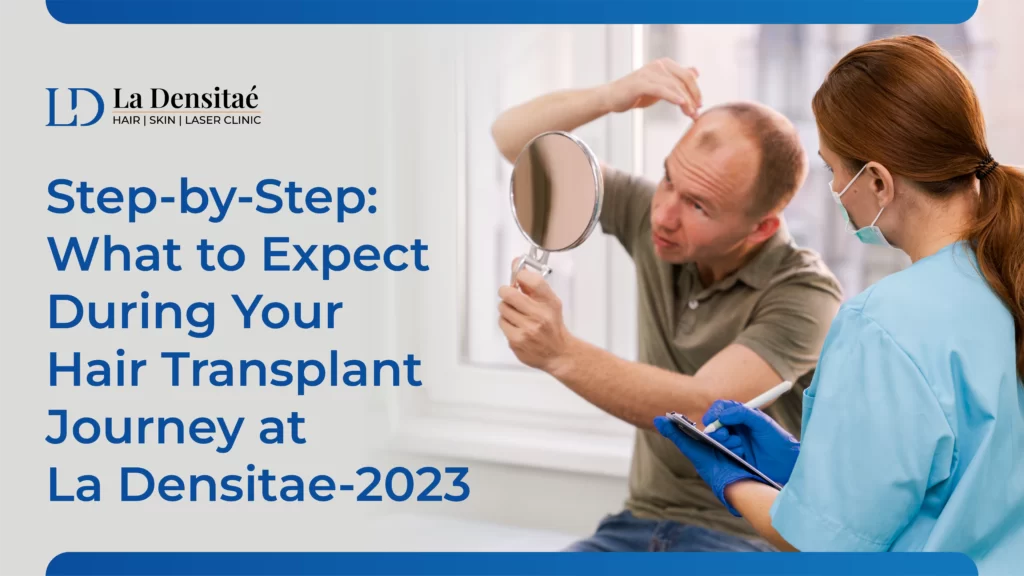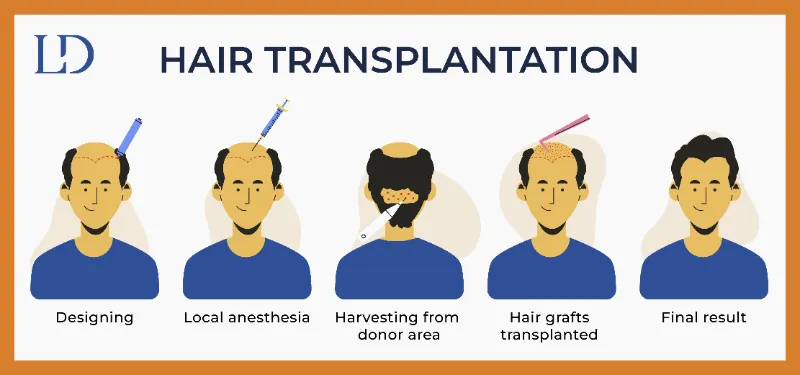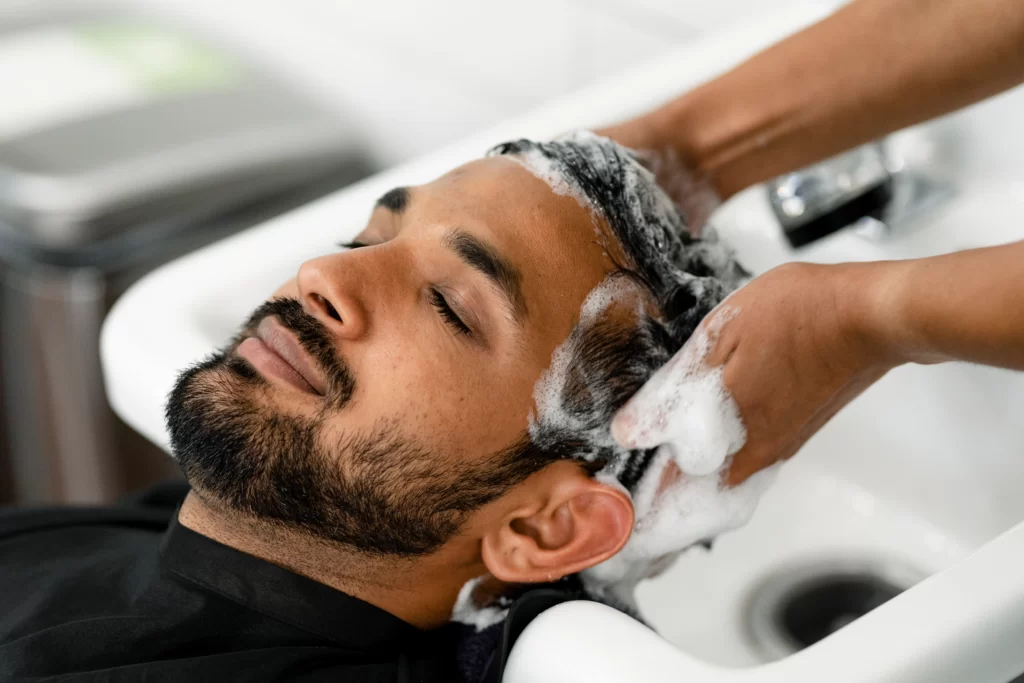Start your hair transplant journey with LaDensitae Hair, Skin & Laser Clinic is a hair transplant clinic that provides a range of hair restoration treatments, including hair transplants and transplantation. Here is a general step-by-step overview of what you can anticipate during your hair transplant journey at LaDensitae. Be aware that depending on the specific treatment you prefer, the actual procedure may differ. Our clinic specializes in restoring hair for those struggling with baldness.

1. Consultation:
Your hair transplant journey begins with a consultation with a hair transplant specialist at LaDensitae. The hair transplant specialist will carefully evaluate the extent of your baldness and bald scalp during this appointment, have a discussion with you about your desired expectations for transplants, and provide recommendations for the right transplantation treatment that aligns with your needs.
2. Preoperative assessment:
Prior to flap surgery, patients will undergo a preoperative assessment at LaDensitae by a surgeon. The recipient area will be evaluated to determine suitability for the treatment and to identify any potential risks.
3. Preparing for the procedure:
- Before your hair transplantation surgery, it’s essential to avoid certain medications and supplements that can increase the risk of bleeding or interfere with anesthesia. Some of these pills include those for scalp transplants.
- Prior to undergoing a hair transplantation surgery, it is crucial to refrain from taking specific medications and supplements that may heighten the chances of bleeding or disrupt the effectiveness of anesthesia. This includes avoiding medications specifically intended for scalp transplants.
- Herbal and Natural Supplements
- Vitamin E supplements
- Patients undergoing flap surgery should inform their surgeon about any prescription or over-the-counter medications, including pills and Advil, they are currently taking before the procedure.
4. The hair transplant procedure:

On the day of the transplantation procedure at LaDensitae, you will arrive at the clinic, where the surgeon and staff will prepare your scalp for the surgery. The hair transplant procedure typically involves harvesting grafts from a donor area and transplanting them to the balding areas of your scalp.
Anesthesia: Local anesthesia will be administered to numb your scalp during hair restoration, hair transplantation, or hair transplants for hair loss.
Harvesting: In a hair transplantation procedure, the surgeon will harvest hair follicles from the donor area, which frequently exists at the back of the head. These follicles, also called grafts, will be carefully gathered and then transplanted onto the scalp. The grafts are selectively placed in regions with low hair density, such as receding hairlines or thinning areas, throughout the transplantation process. This helps to restore natural hair growth and improve overall hair density.
Preparation: After the hair follicles have been carefully harvested, they will undergo an accurate preparation process in order to ensure the condition for transplantation. This crucial step involves carefully cleaning and sorting the harvested hair follicles, ensuring that only the healthiest and most viable grafts are selected for transplantation. The meticulous preparation of the hair follicles is essential for maximizing the success and natural-looking results of the hair transplant procedure.
Implantation: The hair follicles will be transplanted as grafts into the recipient’s scalp area, where hair from a donor is thinning or balding. This meticulous procedure involves making tiny incisions or channels in the recipient site and delicately inserting the grafts into these created openings. The goal of implantation is to ensure the proper placement and angulation of the grafts, allowing them to grow and integrate seamlessly into the recipient’s scalp, resulting in natural-looking hair growth.
Closing: If necessary, sutures or staples will be used to close the donor area after grafts have been harvested for hair transplantation. The transplanted hair will then be carefully placed in the recipient area using a flap technique.
The time required for the hair transplantation procedure totally depends on the number of transplanted hair grafts placed during the hair restoration process. This is the top solution for those people who suffer from hair loss.
5. Timeline of the Healing Process after Hair Transplant Surgery.
- Your scalp will start to heal after the hair transplant surgery. The grafts will be placed in the area where hair loss is evident. The healing process will take time, but it is worth it.
- The timeline of the healing process after hair transplant surgery can vary depending on several factors, including the scalp area where the grafts were placed and the extent of hair loss.
- The type of procedure performed
- The number of grafts transplanted
- The patient’s overall health
Here is a general timeline of what you can expect during your hair restoration recovery:
Day 1 – 3:
During this time of hair transplantation, you may experience some discomfort and swelling in your scalp, where the grafts were placed to combat hair loss. Your surgeon may prescribe pain medication to help manage any pain.
Day 4 – 7:
You should start feeling more comfortable on your scalp during this time. Swelling around the grafts should begin to subside, but you may notice some scabbing around the transplanted hair follicles.
Day 8 – 10:
Scabbing on the scalp should begin to fall off during this time, and you may start to see some new hair growth.
Week 2 – 3:
During this time, any remaining scabs on your scalp after hair transplantation should fall off. Some redness you might experience, but it should be minimal and does not indicate hair loss.
Month 1 – 6:
New hair growth will continue on your scalp during this time, and you should start to see the results of your hair transplant surgery.
Tips for the First Week of Post-Surgery Recovery

The first week of post-surgery recovery from scalp hair transplantation can be the most uncomfortable, especially with the possibility of hair loss.
Make sure you have arranged everything before hair transplantation surgery on your scalp to avoid last moment rush due to hair loss.
It is necessary that you take proper rest before your surgery to prevent hair loss.
Use ice packs: Ice packs can help reduce swelling and discomfort, but they do not have any direct effect on hair loss.
Wear button-up shirts: Wearing button-up shirts can make it easier to dress without disturbing your hair and scalp.
6. Conclusion: Tracking Hair Transplant Growth Month by Month
Congratulations on completing your hair transplant journey! You have come a long way from preparing for surgery to tracking your hair growth month by month. Throughout this process, you have learned about the motivations, expectations, and outcomes of the patient, as well as post-surgery recovery tips and physical changes.
By documenting your progress photos and updates, you can see the amazing improvements that have taken place over time. It is important to continue taking care of your new hair by following the advice of your doctor and keeping up with any necessary maintenance.
Remember that everyone’s hair transplant journey is unique, so it’s essential not to compare yourself to others. Stay positive and focus on your own progress.
If you’re considering a hair transplant, we hope this journey has provided valuable insight into what to expect.
FAQs
Q: How long does new hair take to grow after a transplant?
A: New hair will typically start growing around three months after surgery but may take up to 12 months for full results.
Q: Will I need multiple surgeries?
It depends on individual cases; some people may require more than one hair surgery depending on their desired outcome.
Q: Is there any hair pain during or after the procedure?
Discomfort during the hair procedure can be managed with local anesthesia. Afterward, there may be some mild pain or discomfort which can be relieved with medication prescribed by your doctor.
Q: Can I wear hats or other head coverings that won’t damage my hair after surgery?
It’s best to avoid wearing hats or other tight-fitting headwear for at least two weeks after hair surgery while the grafts heal. After that period, it should be safe to resume wearing them as normal.
Q: How long does it take to recover after hair surgery?
A: The initial recovery period typically takes around 10-14 days, but it can take up to several months for full healing and hair growth.
Q: Will I need to take time off work after hair surgery?
Most people can return to their hair styling job within a few days of surgery, depending on their hairdressing requirements. However, it’s essential to avoid any strenuous activity or bending over during this time.
Q: How much hair transplant cost?
A: The cost of a hair transplant varies depending on individual cases and the number of grafts needed. It’s best to consult with a professional for an accurate estimate.


